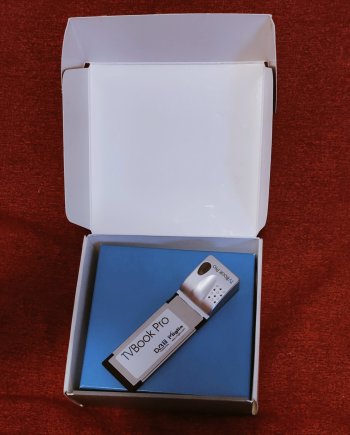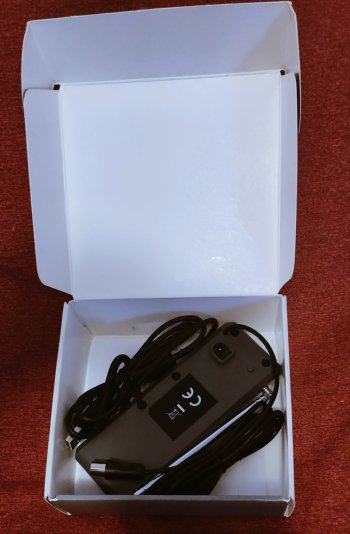The ExpressCard/34 Thread: expansion options for 2006–2011 MacBook Pros
OVERVIEW
Although now a relic, the ExpressCard/34 slot, the successor of PC Card/PCMCIA slots found in PowerBook G3 and the larger PowerBook G4 models, were introduced simultaneously with Apple’s transition to PCIe-equipped Intel architecture.
ExpressCard/34, using a 1x PCIe lane, delivered modular, forward-compatible expansion possibilities for the 2006–2008 15-inch MacBook Pros and 2006–2011 17-inch MacBook Pros. In addition, there were also PCIe-to-ExpressCard adapter expansion cards made for traditional desktop form factors (like the Mac Pro).
This WikiPost, editable by any MR forum community member, collects together known categories of ExpressCard/34 expansion options — both the discontinued and also the currently-offered cards known to exist. Links to external sources on further information on these ExpressCard/34 options are aggregated here for reference only and are not an endorsement for any given product.
Where possible, a short description of ExpressCard capability and compatibility with Mac OS X and/or macOS is provided. Initial entries to this WikiPost collected from past MR threads discussing ExpressCard/34 options. [1] [2]
LEGEND
[*] denotes legacy/discontinued
[+] denotes recently proposed product
USB
Delock 1 × USB 3.0: unknown compatibility with Mac OS X
nanoTECH USB 3.0 × 2 (version 1): compatible for Mac OS X 10.6.8 to 10.10.5
nanoTECH USB 3.0 × 2 (version 2): compatible for Mac OS X 10.8.2+
Sonnet USB 2.0 × 4: [*] Mac OS X compatible
Sonnet USB 3.0 × 2 (Rev. A, pre-2014): [*] at least Mac OS X 10.6
Sonnet USB 3.0 × 2 (Rev. B, 2014): [*] unknown Mac OS X compatibility
StarTech USB 2.0 × 2: Mac OS X 10.6 to 10.8.5-compatible
FIREWIRE
Belkin FireWire 800 × 2: [*] Mac OS X 10.4.3+ compatible
LaCie FireWire 800 × 2: [*] Mac OS X compatible
SIIG FireWire 400 × 2: [*] Mac OS X 10.4.3+ compatible
Sonnet FireWire 800 × 2: [*] Mac OS X compatible
Sonnet FireWire 800 × 2 Pro: [*] Mac OS X compatible
StarTech FireWire 400/1394a × 2: [*] Mac OS X compatible
StarTech FireWire 800/1394b × 2: Mac OS X 10.4.3 to 10.11 compatible
MEDIA CARDS (SD, CF, etc.)
Delkin 24-in-1 Multi-card Adapter: [*] unknown Mac OS X compatibility
Griffin 5:1 MultiCard Reader: [*] Mac OS X compatible
SanDisk Extreme Pro CF ExpressCard Adapter: [*] compatible with Mac OS X 10.4.3+
Sonnet Multimedia Memory [SD] Card Reader & Writer: [*] Mac OS X compatible; for SDXC, at least Mac OS X 10.6.5 is required
Sonnet Pro Dual Compact Flash ×2 Adapter: [*] Mac OS X compatible
Sonnet SDHC card adapter for SxS Camera Slot: [*] unknown Mac OS X compatibility
Sonnet SDXC UHS-I Pro Reader/Writer: [*] Mac OS X compatible
Sony MEAD-SD02 SDHC/SDXC Card Adapter: Mac OS X compatible
NETWORKING
Delock 1 × Gigabit Ethernet: unknown compatibility with Mac OS X
Sierra Wireless AirCard 597E: [*] Mac OS X compatible
Sonnet Presto Gigabit Ethernet Pro (Rev A): [*] Mac OS X compatible (and compatible to at least macOS 10.12.6)
Sonnet Presto Gigabit Ethernet Pro (Rev B): [*] Mac OS X compatible (and compatible to at least macOS 10.12.6)
StarTech Gigabit Ethernet × 2 NIC: [*] Mac OS X 10.6 to 10.9 compatible
eSATA & SAS
Delock 2 × eSATA 3GB/s: compatible with Mac OS X 10.5+
FirmTek SeriTek/2SM2-E eSATA 3GB/s × 2: compatible with Mac OS X
FirmTek SeriTek/6G eSATA 6GB/s × 2, plus Port Multiplier: compatible with Mac OS X 10.6.8+ (bootable from 2011 17" MacBook Pros)
Sonnet Tempo Edge eSATA × 1: [*] compatible with Mac OS X 10.4.3+
Sonnet Tempo eSATA × 2: [*] compatible with Mac OS X 10.4.3+
Sonnet Tempo eSATA 6GB/s × 2: [*] compatible with Mac OS X 10.5+
Sonnet Tempo eSATA 6GB/s × 2 Pro: [*] compatible with at least Mac OS X 10.5 and 10.6.8
Sonnet Tempo eSATA × 2 Pro: [*] compatible with Mac OS X 10.4.3+
Sonnet Tempo Edge eSATA × 1: [*] compatible with Mac OS X 10.5+
Sonnet Tempo Edge eSATA Pro × 1 6GB/s: [*] compatible with at least Mac OS X 10.5 and 10.6.8
Sonnet Tempo SAS × 1 Pro: [*] compatible with Mac OS X
MULTI-FUNCTION
Sonnet FireWire 400 × 2 & USB 2.0 × 1 combo: [*] Mac OS X compatible
Sonnet Tempo Duo eSATA × 2 & USB 3.0 × 2 combo: [*] requires OS X 10.8.5
Sonnet Tempo Duo eSATA 6GB/s × 2 & USB 3.0 × 2 combo: [*] requires OS X 10.8.5
PCIe ADAPTERS
SIIG PCIe to ExpressCad/54 adapter: unknown Mac OS X compatibility
Sonnet PCIe Bus Extender: [*] unknown Mac OS X compatibility
eGPU KITS
EXP GDC Beast: Barebones ExpressCard to PCIe ×16 adapter. Compatible (tested) with Mac OS X 10.6.8 through 10.11.6 - specific compatibility depends on which GPU is used.
VillageTronic ViDock Family: [*] Boxed ExpressCard to PCIe ×16 adapter solution. Compatible with Mac OS X (versions unknown - depends on which GPU is used).
OTHER
Delock 1 × Serial Port: compatible with Mac OS X 10.5+
Miglia TVBook Pro Express TV adapter compatible with Mac OS X 10.4+
MOTU HDX-SDI PCIe Video Interface: compatible with Mac OS X
SIIG USB-to-USB-based-ExpressCard/34 dongle: [*] Mac OS X 10.3+
Sonnet Echo ExpressCard Pro: adapter kit for Thunderbolt-equipped (i.e., 2011 and later) Macs to utilize legacy ExpressCard/34 cards
StarTech ExpressCard/34 to CardBus adapter: Mac OS X compatible
StarTech RS232 DB9 USB-based adapter: Mac OS X 10.6 to macOS 11.2
ThinkMods ExpressCard34-to-NVMe m.2 adapter: [+] at this point, this is crowdfund vapourware from 2020 & unknown whether it will be macOS-compatible
OVERVIEW
Although now a relic, the ExpressCard/34 slot, the successor of PC Card/PCMCIA slots found in PowerBook G3 and the larger PowerBook G4 models, were introduced simultaneously with Apple’s transition to PCIe-equipped Intel architecture.
ExpressCard/34, using a 1x PCIe lane, delivered modular, forward-compatible expansion possibilities for the 2006–2008 15-inch MacBook Pros and 2006–2011 17-inch MacBook Pros. In addition, there were also PCIe-to-ExpressCard adapter expansion cards made for traditional desktop form factors (like the Mac Pro).
This WikiPost, editable by any MR forum community member, collects together known categories of ExpressCard/34 expansion options — both the discontinued and also the currently-offered cards known to exist. Links to external sources on further information on these ExpressCard/34 options are aggregated here for reference only and are not an endorsement for any given product.
Where possible, a short description of ExpressCard capability and compatibility with Mac OS X and/or macOS is provided. Initial entries to this WikiPost collected from past MR threads discussing ExpressCard/34 options. [1] [2]
LEGEND
[*] denotes legacy/discontinued
[+] denotes recently proposed product
USB
Delock 1 × USB 3.0: unknown compatibility with Mac OS X
nanoTECH USB 3.0 × 2 (version 1): compatible for Mac OS X 10.6.8 to 10.10.5
nanoTECH USB 3.0 × 2 (version 2): compatible for Mac OS X 10.8.2+
Sonnet USB 2.0 × 4: [*] Mac OS X compatible
Sonnet USB 3.0 × 2 (Rev. A, pre-2014): [*] at least Mac OS X 10.6
Sonnet USB 3.0 × 2 (Rev. B, 2014): [*] unknown Mac OS X compatibility
StarTech USB 2.0 × 2: Mac OS X 10.6 to 10.8.5-compatible
FIREWIRE
Belkin FireWire 800 × 2: [*] Mac OS X 10.4.3+ compatible
LaCie FireWire 800 × 2: [*] Mac OS X compatible
SIIG FireWire 400 × 2: [*] Mac OS X 10.4.3+ compatible
Sonnet FireWire 800 × 2: [*] Mac OS X compatible
Sonnet FireWire 800 × 2 Pro: [*] Mac OS X compatible
StarTech FireWire 400/1394a × 2: [*] Mac OS X compatible
StarTech FireWire 800/1394b × 2: Mac OS X 10.4.3 to 10.11 compatible
MEDIA CARDS (SD, CF, etc.)
Delkin 24-in-1 Multi-card Adapter: [*] unknown Mac OS X compatibility
Griffin 5:1 MultiCard Reader: [*] Mac OS X compatible
SanDisk Extreme Pro CF ExpressCard Adapter: [*] compatible with Mac OS X 10.4.3+
Sonnet Multimedia Memory [SD] Card Reader & Writer: [*] Mac OS X compatible; for SDXC, at least Mac OS X 10.6.5 is required
Sonnet Pro Dual Compact Flash ×2 Adapter: [*] Mac OS X compatible
Sonnet SDHC card adapter for SxS Camera Slot: [*] unknown Mac OS X compatibility
Sonnet SDXC UHS-I Pro Reader/Writer: [*] Mac OS X compatible
Sony MEAD-SD02 SDHC/SDXC Card Adapter: Mac OS X compatible
NETWORKING
Delock 1 × Gigabit Ethernet: unknown compatibility with Mac OS X
Sierra Wireless AirCard 597E: [*] Mac OS X compatible
Sonnet Presto Gigabit Ethernet Pro (Rev A): [*] Mac OS X compatible (and compatible to at least macOS 10.12.6)
Sonnet Presto Gigabit Ethernet Pro (Rev B): [*] Mac OS X compatible (and compatible to at least macOS 10.12.6)
StarTech Gigabit Ethernet × 2 NIC: [*] Mac OS X 10.6 to 10.9 compatible
eSATA & SAS
Delock 2 × eSATA 3GB/s: compatible with Mac OS X 10.5+
FirmTek SeriTek/2SM2-E eSATA 3GB/s × 2: compatible with Mac OS X
FirmTek SeriTek/6G eSATA 6GB/s × 2, plus Port Multiplier: compatible with Mac OS X 10.6.8+ (bootable from 2011 17" MacBook Pros)
Sonnet Tempo Edge eSATA × 1: [*] compatible with Mac OS X 10.4.3+
Sonnet Tempo eSATA × 2: [*] compatible with Mac OS X 10.4.3+
Sonnet Tempo eSATA 6GB/s × 2: [*] compatible with Mac OS X 10.5+
Sonnet Tempo eSATA 6GB/s × 2 Pro: [*] compatible with at least Mac OS X 10.5 and 10.6.8
Sonnet Tempo eSATA × 2 Pro: [*] compatible with Mac OS X 10.4.3+
Sonnet Tempo Edge eSATA × 1: [*] compatible with Mac OS X 10.5+
Sonnet Tempo Edge eSATA Pro × 1 6GB/s: [*] compatible with at least Mac OS X 10.5 and 10.6.8
Sonnet Tempo SAS × 1 Pro: [*] compatible with Mac OS X
MULTI-FUNCTION
Sonnet FireWire 400 × 2 & USB 2.0 × 1 combo: [*] Mac OS X compatible
Sonnet Tempo Duo eSATA × 2 & USB 3.0 × 2 combo: [*] requires OS X 10.8.5
Sonnet Tempo Duo eSATA 6GB/s × 2 & USB 3.0 × 2 combo: [*] requires OS X 10.8.5
PCIe ADAPTERS
SIIG PCIe to ExpressCad/54 adapter: unknown Mac OS X compatibility
Sonnet PCIe Bus Extender: [*] unknown Mac OS X compatibility
eGPU KITS
EXP GDC Beast: Barebones ExpressCard to PCIe ×16 adapter. Compatible (tested) with Mac OS X 10.6.8 through 10.11.6 - specific compatibility depends on which GPU is used.
VillageTronic ViDock Family: [*] Boxed ExpressCard to PCIe ×16 adapter solution. Compatible with Mac OS X (versions unknown - depends on which GPU is used).
OTHER
Delock 1 × Serial Port: compatible with Mac OS X 10.5+
Miglia TVBook Pro Express TV adapter compatible with Mac OS X 10.4+
MOTU HDX-SDI PCIe Video Interface: compatible with Mac OS X
SIIG USB-to-USB-based-ExpressCard/34 dongle: [*] Mac OS X 10.3+
Sonnet Echo ExpressCard Pro: adapter kit for Thunderbolt-equipped (i.e., 2011 and later) Macs to utilize legacy ExpressCard/34 cards
StarTech ExpressCard/34 to CardBus adapter: Mac OS X compatible
StarTech RS232 DB9 USB-based adapter: Mac OS X 10.6 to macOS 11.2
ThinkMods ExpressCard34-to-NVMe m.2 adapter: [+] at this point, this is crowdfund vapourware from 2020 & unknown whether it will be macOS-compatible
Last edited:




